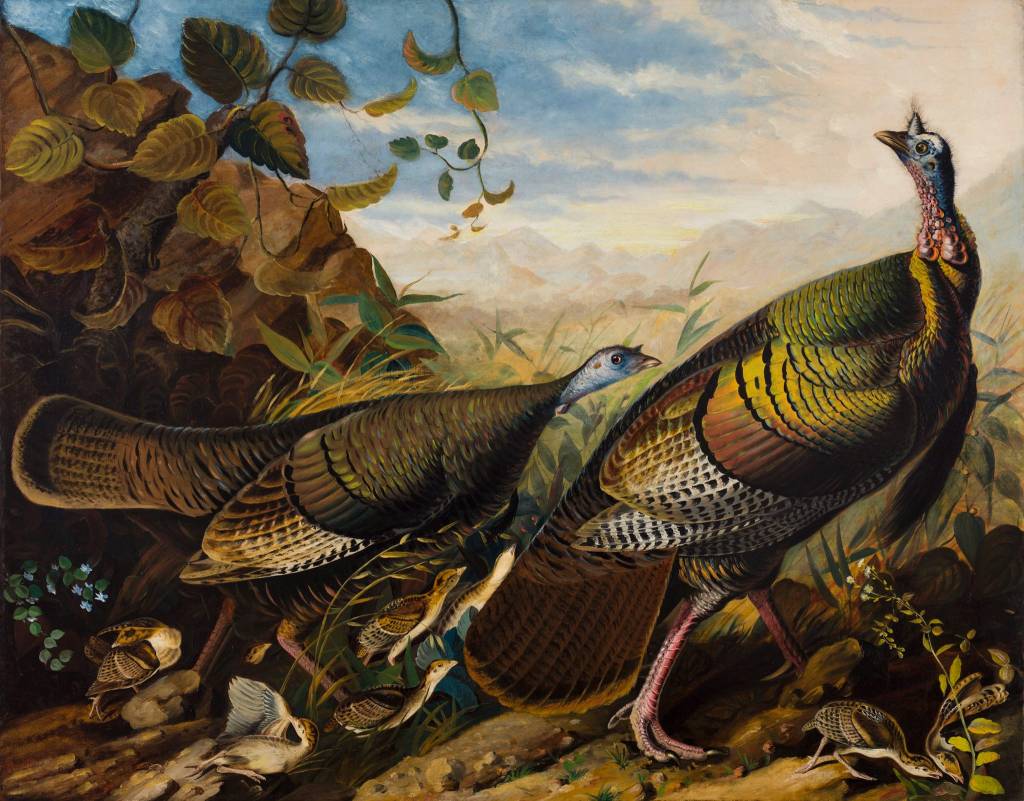
John James Audubon, 1785 – 1851
Wild Turkey Cock, Hen and Young, 1826
Oil on linen
Crystal Bridges Museum of American Art
Black Friday is behind us, yet many of us are still finding ways to get creative with the post-Thanksgiving leftover turkey. Whether you love this traditional holiday fowl or banish it to an obligatory, though symbolic, space on your plate, we all know that Thanksgiving sure wouldn’t be complete without it. A native of North America that was here long before the pilgrims, the turkey has a long and important status in the United States, with admirers from Benjamin Franklin to artist John James Audubon, whose oil painting Wild Turkey Cock, Hen and Young hangs in Crystal Bridges’ permanent collection.
John James Audubon’s love of nature would impress even the most ardent environmentalist. He traveled all over the United States cataloging native birds for his book The Birds of America, a collection of 435 portraits of every known bird in the United States. (We actually have a copy of this rare book in the Crystal Bridges Library, an elephant double folio, which looks just like it sounds–massive!)
We know the turkey held a special place in Audubon’s heart, because not only did he possess a miniature gold turkey seal, but the bird also featured prominently on his personal calling cards. His portrait of Turkey Cock, Hen, and Young represents the value of the turkey to many early Europeans as a symbol of the New World, as well as an important resource to Indigenous groups who pre-dated European colonization.
Far from the first to discover the value of this funny-looking fowl, the Aztecs domesticated the huexolotl, as they called the turkey, and valued it so much as a food source that they also revered it as a god, honoring it with two religious festivals a year! The Spanish, though, were taken quite aback by what they called “a kind of a peacock with great hanging chins.” They quickly got past their disdain however, shipping the bird back to Europe to be enjoyed in the royal courts (although probably not deep fried). North American Indians also revered the turkey as a spiritual symbol; but after white settlers arrived, the population of wild turkeys dwindled until they were nearly extinct. And although founding father Benjamin Franklin famously extolled their virtues in a letter to his daughter, it is likely he was joking when he suggested that the turkey might be preferable to the eagle as a national symbol.
In Turkey Cock, Hens, and Young, Audubon actually combined into a single composition images from two separate watercolors he had completed for The Birds of America. Audubon originally drew the Hen and her Young while traveling down the Mississippi in 1820. The male turkey he found wandering about in a thicket of cane grass in Louisiana in 1825. He bagged the bird and arranged it in a lively position in his studio, where he used his model until its freshness dissipated. In Edinburgh, in 1826, Audubon combined the two images, placing them at the edge of a forest and adding a mountain landscape in the background. Realistically, hens drive the male turkeys away from their chicks, and only Audubon’s artistic liberty and admiration for the birds drew the unlikely group together.
It’s something to think about, at this time of year when we all join together with friends and family (likely and unlikely) to give thanks for all the beauty and bounty of nature we experience every day in the United States.
Editor’s Note: If you’d like to read more about John James Audubon, you can check out an earlier three-part blog series on the artist and adventurer here.
Sources:
http://www.history.org/foundation/journal/holiday06/turkeys.cfm



